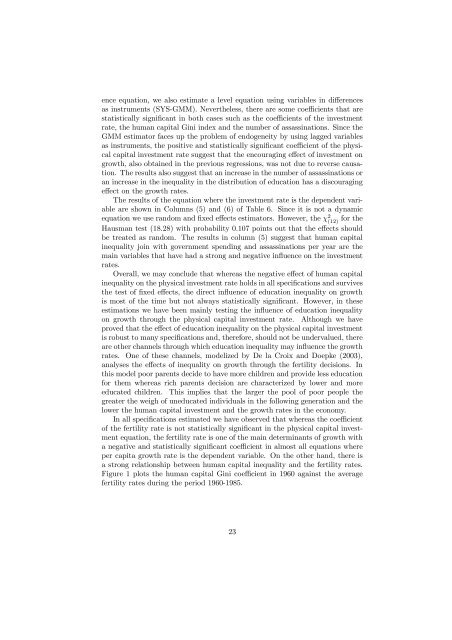Amparo Castelló-Climent, Universidad Carlos III de Madrid ... - Ivie
Create successful ePaper yourself
Turn your PDF publications into a flip-book with our unique Google optimized e-Paper software.
ence equation, we also estimate a level equation using variables in differences<br />
as instruments (SYS-GMM). Nevertheless, there are some coefficients that are<br />
statistically significantinbothcasessuchasthecoefficients of the investment<br />
rate, the human capital Gini in<strong>de</strong>x and the number of assassinations. Since the<br />
GMM estimator faces up the problem of endogeneity by using lagged variables<br />
as instruments, the positive and statistically significant coefficient of the physical<br />
capital investment rate suggest that the encouraging effect of investment on<br />
growth, also obtained in the previous regressions, was not due to reverse causation.<br />
The results also suggest that an increase in the number of assassinations or<br />
an increase in the inequality in the distribution of education has a discouraging<br />
effect on the growth rates.<br />
The results of the equation where the investment rate is the <strong>de</strong>pen<strong>de</strong>nt variable<br />
are shown in Columns (5) and (6) of Table 6. Since it is not a dynamic<br />
equation we use random and fixed effects estimators. However, the χ 2 (12)<br />
for the<br />
Hausman test (18.28) with probability 0.107 points out that the effects should<br />
be treated as random. The results in column (5) suggest that human capital<br />
inequality join with government spending and assassinations per year are the<br />
main variables that have had a strong and negative influence on the investment<br />
rates.<br />
Overall, we may conclu<strong>de</strong> that whereas the negative effect of human capital<br />
inequality on the physical investment rate holds in all specifications and survives<br />
the test of fixed effects, the direct influence of education inequality on growth<br />
is most of the time but not always statistically significant. However, in these<br />
estimations we have been mainly testing the influence of education inequality<br />
on growth through the physical capital investment rate. Although we have<br />
proved that the effect of education inequality on the physical capital investment<br />
is robust to many specifications and, therefore, should not be un<strong>de</strong>rvalued, there<br />
are other channels through which education inequality may influence the growth<br />
rates. One of these channels, mo<strong>de</strong>lized by De la Croix and Doepke (2003),<br />
analyses the effects of inequality on growth through the fertility <strong>de</strong>cisions. In<br />
this mo<strong>de</strong>l poor parents <strong>de</strong>ci<strong>de</strong> to have more children and provi<strong>de</strong> less education<br />
for them whereas rich parents <strong>de</strong>cision are characterized by lower and more<br />
educated children. This implies that the larger the pool of poor people the<br />
greater the weigh of uneducated individuals in the following generation and the<br />
lower the human capital investment and the growth rates in the economy.<br />
In all specifications estimated we have observed that whereas the coefficient<br />
of the fertility rate is not statistically significant in the physical capital investment<br />
equation, the fertility rate is one of the main <strong>de</strong>terminants of growth with<br />
a negative and statistically significant coefficient in almost all equations where<br />
per capita growth rate is the <strong>de</strong>pen<strong>de</strong>nt variable. On the other hand, there is<br />
a strong relationship between human capital inequality and the fertility rates.<br />
Figure 1 plots the human capital Gini coefficient in 1960 against the average<br />
fertility rates during the period 1960-1985.<br />
23

















